Vehicle-To-Grid for Peak Shaving to Unlock the Integration of Distributed Heat Pumps in a Swedish Neighborhood
Abstract
1. Introduction
2. Case Study
3. Scenarios
3.1. Reference Scenario
3.2. V2G Integration Scenario
4. Models
4.1. Models for the Reference Scenario
- A power flow model for the electricity distribution grid. An open source tool called Pandapower [31] was used for this purpose.
- A reduced order model for the thermal demand of the BBs. This model is part of the Modelica Buildings library [32], maintained by the International Building Performance Association (IBPSA).
- A Python model based on a coefficient of performance formula [33] for the HPs.
- Python models based on energy balance equations for the DH, the TES, and the electrical backup units.
- A Python in-house operation logic for the control of the heating supply.
4.2. Models for the V2G Integration Scenario
- The grid overloading power profiles generated as a result of the reference scenario for the critical cables.
- Stochastic driving patterns for the EVs owned by the inhabitants of Hammarby Sjöstad, assuming a 100% penetration of this technology.
- Cable 1—LU 1
- Cable 2—Llugnw24, Llugnw26, Llugnw27
- Cable 3—Luddnw3
- Cable 4—Llugnw6, Llugnw7
- The total number of vehicles was allocated to each BB proportionally to the number of inhabitants and to the number of cars per person.
- The starting times for the cars’ trips were randomized around an initial value defined per each hour of the day [36]. The “random” Python module was used for this purpose.
- The daily trips for each car were simulated by assigning, on a random basis (“random” module), the travel distances, the speed boundaries, and the initial SoC.
- The number of cars per each station (or BB).
- The share of each cars’ brand per each station (or BB).
- The starting and ending times of each trip per each car.
- The end-of-the-day SoC per each car.
- The available power hourly profile per each car per each station (or BB).
- A potential overloading was detected on an upstream cable.
- One or more EVs were parked with an SoC over 80% at a corresponding charging/discharging station.
5. Results
6. Conclusions
Author Contributions
Funding
Conflicts of Interest
References
- Allerup, J. Sweden’s Climate Act and Climate Policy Framework. Available online: http://www.swedishepa.se/Environmental-objectives-and-cooperation/Swedish-environmental-work/Work-areas/Climate/Climate-Act-and-Climate-policy-framework-/ (accessed on 15 October 2019).
- IEA. Sweden 2019 Review; IEA: Paris, France, 2019. [Google Scholar]
- Duveau, T.; Tewes, N. Climate Scorecard Sweden; WWF and Allianz: Frankfurt, Germany, 2009. [Google Scholar]
- Moro, A.; Lonza, L. Electricity carbon intensity in European Member States: Impacts on GHG emissions of electric vehicles. Transp. Res. Part. D Transp. Environ. 2017, 64, 5–14. [Google Scholar] [CrossRef] [PubMed]
- Electricity Hammarby Sjöstad 2.0. Available online: http://hammarbysjostad20.se/?lang=en (accessed on 12 December 2019).
- Pasichnyi, O.; Wallin, J.; Kordas, O. Data-driven building archetypes for urban building energy modelling. Energy 2019, 181, 360–377. [Google Scholar] [CrossRef]
- IEA. Nordic Energy Technology Perspectives 2016. In Energy Technology Policy Diver; IEA: Paris, France, 2016; p. 269. [Google Scholar]
- Choi, W.; Wu, Y.; Han, D.; Gorman, J.; Palavicino, P.C.; Lee, W.; Sarlioglu, B. Reviews on grid-connected inverter, utility-scaled battery energy storage system, and vehicle-to-grid application-Challenges and opportunities. In Proceedings of the 2017 IEEE Transportation Electrification Conference, Chicago, IL, USA, 22–24 June 2017; pp. 203–210. [Google Scholar]
- Yilmaz, M.; Krein, P.T. Review of the impact of vehicle-to-grid technologies on distribution systems and utility interfaces. IEEE Trans. Power Electron. 2013, 28, 5673–5689. [Google Scholar] [CrossRef]
- Steward, D. Critical Elements of Vehicle-to- Grid (V2G) Economics; NREL: Golden, CO, USA, 2017. [Google Scholar]
- IRENA. Innovation Outlook: Smart Charging for Electric Vehicles; IRENA: Abu Dhabi, UAE, 2019. [Google Scholar]
- Arnaudo, M.; Topel, M.; Laumert, B. Techno-economic analysis of demand side flexibility to enable the integration of distributed heat pumps within a Swedish neighborhood. Energy 2020, 195, 117012. [Google Scholar] [CrossRef]
- Saber, A.Y.; Venayagamoorthy, G.K. Plug-in vehicles and renewable energy sources for cost and emission reductions. IEEE Trans. Ind. Electron. 2011, 58, 1229–1238. [Google Scholar] [CrossRef]
- Chukwu, U.C.; Mahajan, S.M. V2G electric power capacity estimation and ancillary service market evaluation. In Proceedings of the 2011 IEEE Power & Energy Society General Meeting, Detroit, MI, USA, 24–28 July 2011; pp. 1–8. [Google Scholar]
- Wang, Z.; Wang, S. Grid power peak shaving and valley filling using vehicle-to-grid systems. IEEE Trans. Power Deliv. 2013, 28, 1822–1829. [Google Scholar] [CrossRef]
- Kumar, A.; Bhalla, V.; Kumar, P. Impact of Plug-in Hybrid Electric Vehicles Integrated with Economic Unit Commitment of Power system. In Proceedings of the 2017 IEEE Transportation Electrification Conference (ITEC-India), Pune, India, 13–16 December 2017. [Google Scholar]
- Shinde, P.; Swarup, K.S. Optimal Electric Vehicle charging schedule for demand side management. In Proceedings of the 2016 First International Conference on Sustainable Green Building Communities, Chennai, India, 18–20 December 2016. [Google Scholar]
- Yang, Z.; Liao, Q.; Tang, F.; Peng, S.; Fang, F.; Xu, Y. Dispatch of EV Loads in Active Distribution Network Considering Energy Storage Characteristic. In Proceedings of the 2017 IEEE Conference on Energy Internet and Energy System Integration (EI2), Beijing, China, 26–28 November 2017. [Google Scholar]
- Debnath, U.K.; Ahmad, I.; Habibi, D.; Saber, A.Y. Energy storage model with gridable vehicles for economic load dispatch in the smart grid. Int. J. Electr. Power Energy Syst. 2015, 64, 1017–1024. [Google Scholar] [CrossRef]
- Ahmadian, A.; Sedghi, M.; Mohammadi-Ivatloo, B.; Elkamel, A.; Aliakbar Golkar, M.; Fowler, M. Cost-Benefit Analysis of V2G Implementation in Distribution Networks Considering PEVs Battery Degradation. IEEE Trans. Sustain. Energy 2018, 9, 961–970. [Google Scholar] [CrossRef]
- Jain, P.; Jain, T. Development of V2G and G2V Power Profiles and Their Implications on Grid Under Varying Equilibrium of Aggregated Electric Vehicles. Int. J. Emerg. Electr. Power Syst. 2016, 17, 101–115. [Google Scholar] [CrossRef]
- Freeman, G.M.; Drennen, T.E.; White, A.D. Can parked cars and carbon taxes create a profit? The economics of vehicle-to-grid energy storage for peak reduction. Energy Policy 2017, 106, 183–190. [Google Scholar] [CrossRef]
- Gough, R.; Dickerson, C.; Rowley, P.; Walsh, C. Vehicle-to-grid feasibility: A techno-economic analysis of EV-based energy storage. Appl. Energy 2017, 192, 12–23. [Google Scholar] [CrossRef]
- White, C.D.; Zhang, K.M. Using vehicle-to-grid technology for frequency regulation and peak-load reduction. J. Power Sources 2011, 196, 3972–3980. [Google Scholar] [CrossRef]
- Mahmud, K.; Morsalin, S.; Kafle, Y.R.; Town, G.E. Improved peak shaving in grid-connected domestic power systems combining photovoltaic generation, battery storage, and V2G-capable electric vehicle. In Proceedings of the 2016 IEEE International Conference on Power Systems Technology, Wollongong, NSW, Australia, 28 September–1 October 2016; pp. 1–4. [Google Scholar]
- Wang, Z.; Tang, Y.; Chen, X.; Men, X.; Cao, J.; Wang, H. Optimized daily dispatching strategy of building-integrated energy systems considering vehicle to grid technology and room temperature control. Energies 2018, 11, 1287. [Google Scholar] [CrossRef]
- Lin, H.; Liu, Y.; Sun, Q.; Xiong, R.; Li, H.; Wennersten, R. The impact of electric vehicle penetration and charging patterns on the management of energy hub–A multi-agent system simulation. Appl. Energy 2018, 230, 189–206. [Google Scholar] [CrossRef]
- Puerto, P. zerOBNL. Available online: https://github.com/IntegrCiTy/zerobnl (accessed on 26 October 2018).
- Boverket Ska Din Byggnad ha en Energideklaration? Available online: https://www.boverket.se/sv/energideklaration/energideklaration/ (accessed on 27 June 2019).
- Puerto, P.; Widl, E.; Page, J. ZerOBNL: A framework for distributed and reproducible co-simulation. In Proceedings of the 2019 7th Workshop on Modeling and Simulation of Cyber-Physical Energy System, Montreal, QC, Canada, 15 April 2019; pp. 1–6. [Google Scholar]
- Pandapower. Available online: https://pandapower.readthedocs.io/en/v1.6.0/about.html (accessed on 11 October 2018).
- Open Modelica Thermal Zone Reduced Order Models. Available online: https://build.openmodelica.org/Documentation/IBPSA.ThermalZones.ReducedOrder.RC.UsersGuide.html (accessed on 14 October 2019).
- Patteeuw, D.; Helsen, L. Combined design and control optimization of residential heating systems in a smart-grid context. Energy Build. 2016, 133, 640–657. [Google Scholar] [CrossRef]
- Bunsen, T.; Cazzola, P.; D’Amore, L.; Gorner, M.; Scheffer, S.; Schuitmaker, R.; Signollet, H.; Tattini, J.; Paoli, J.T.L. Global EV Outlook 2019 to Electric Mobility; OECD: Paris, France, 2019; p. 232. [Google Scholar]
- Statistikmyndigheten SCB Statistikdatabasen. Available online: http://www.statistikdatabasen.scb.se/pxweb/sv/ssd/ (accessed on 1 February 2020).
- Trafikverket Öppna Data från Trafikverket. Available online: https://www.trafikverket.se/tjanster/Oppna_data/ (accessed on 1 February 2020).
- Liu, Z.; Wu, Q.; Nielsen, A.H.; Wang, Y. Day-ahead energy planning with 100% electric vehicle penetration in the nordic region by 2050. Energies 2014, 7, 1733–1749. [Google Scholar] [CrossRef]

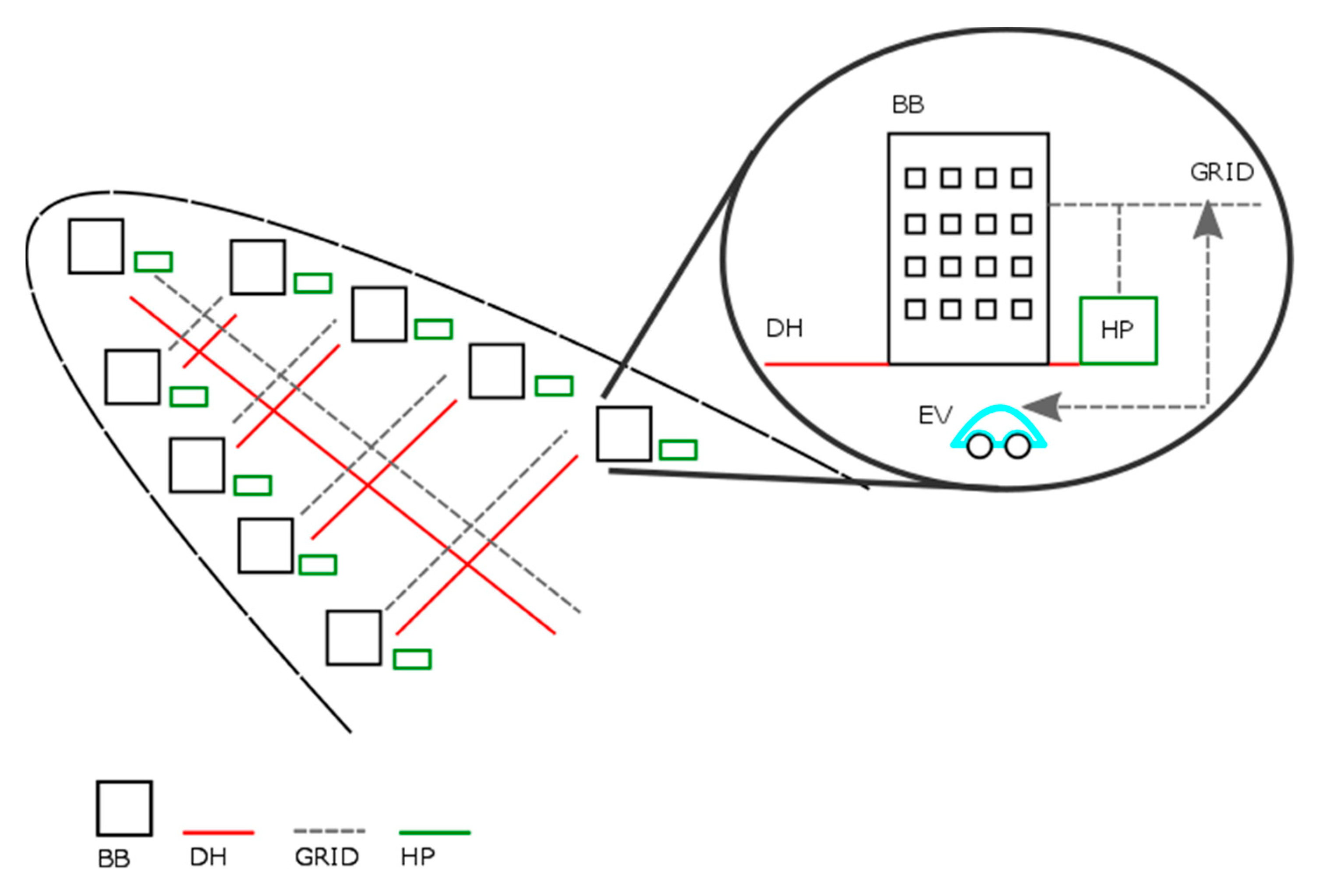
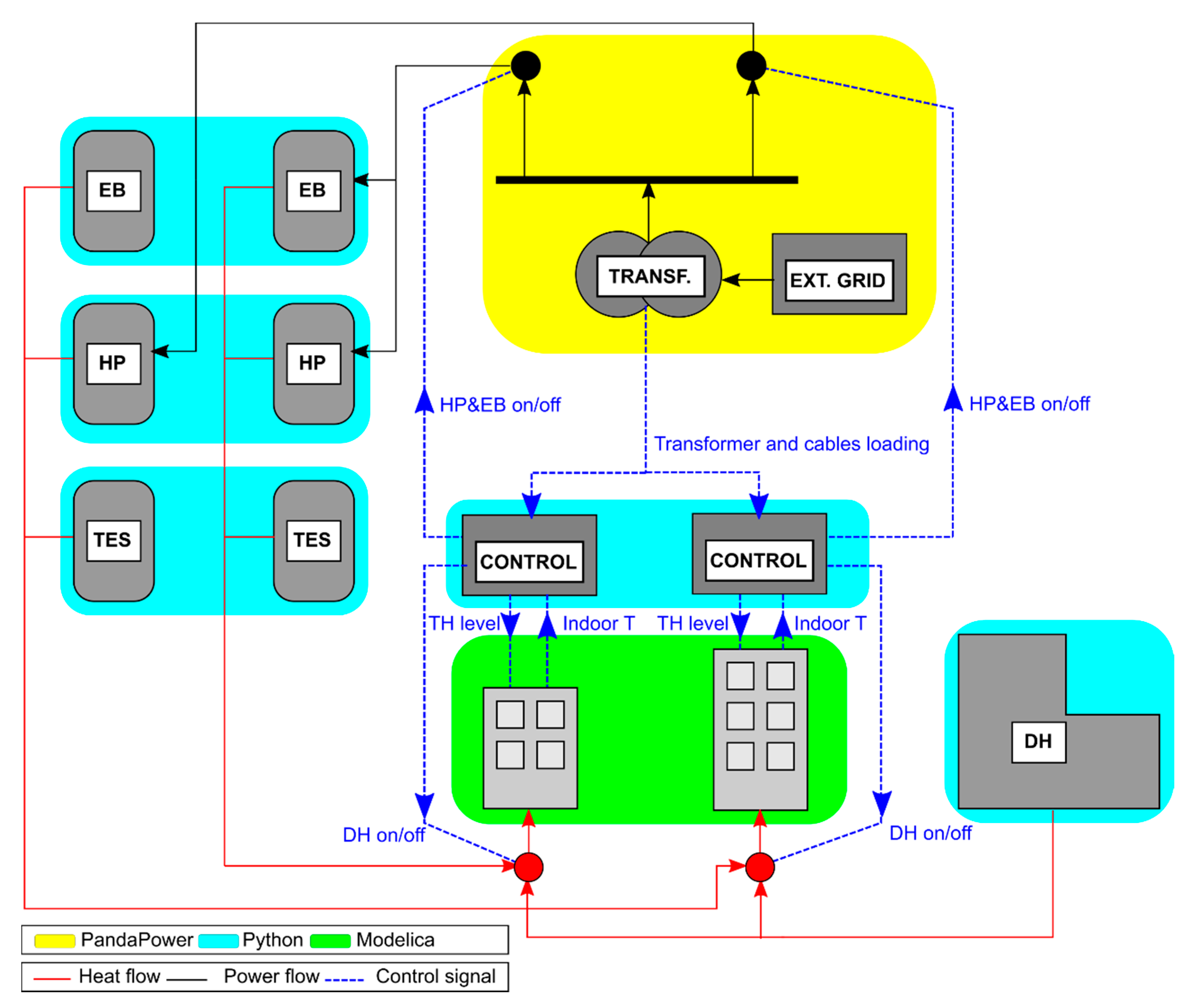


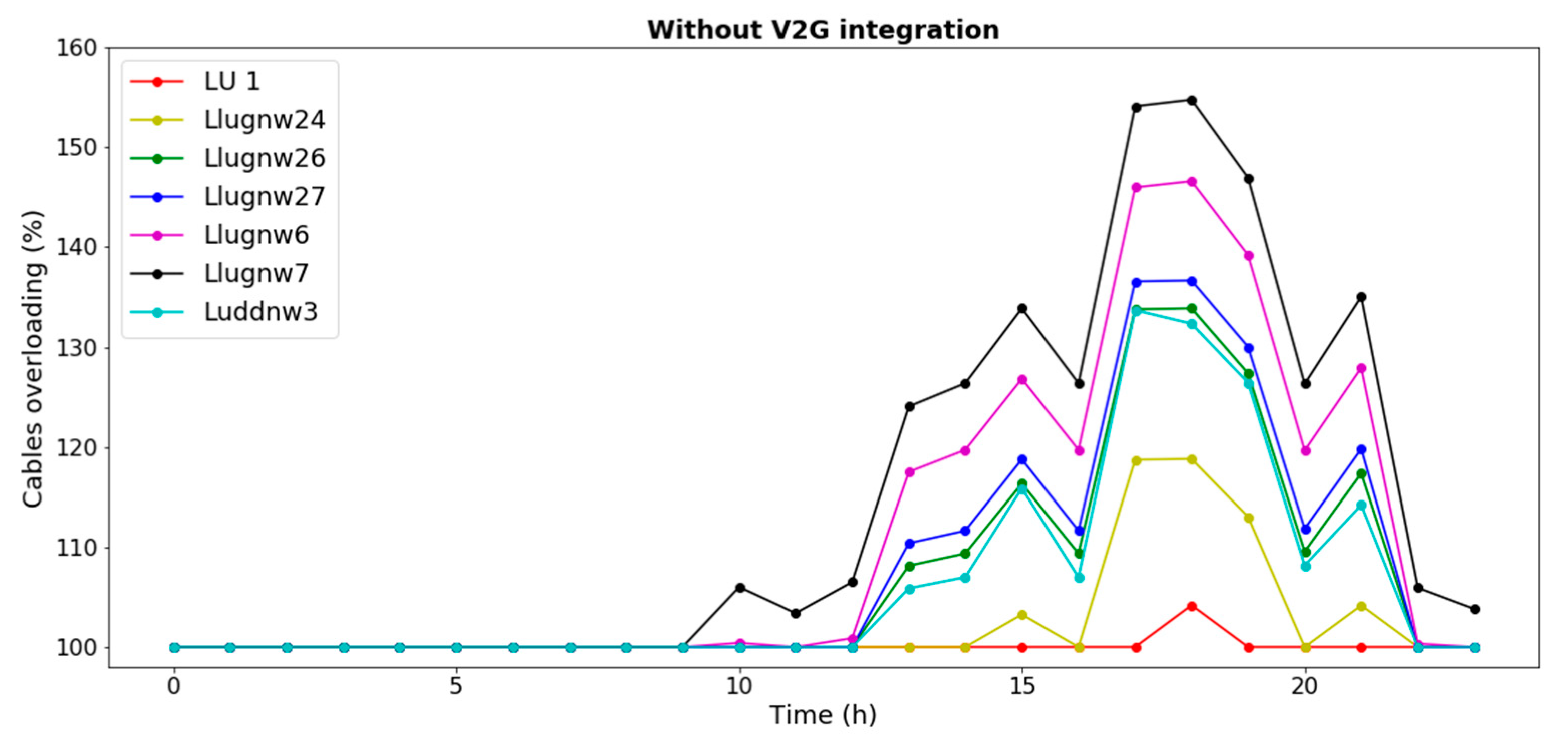
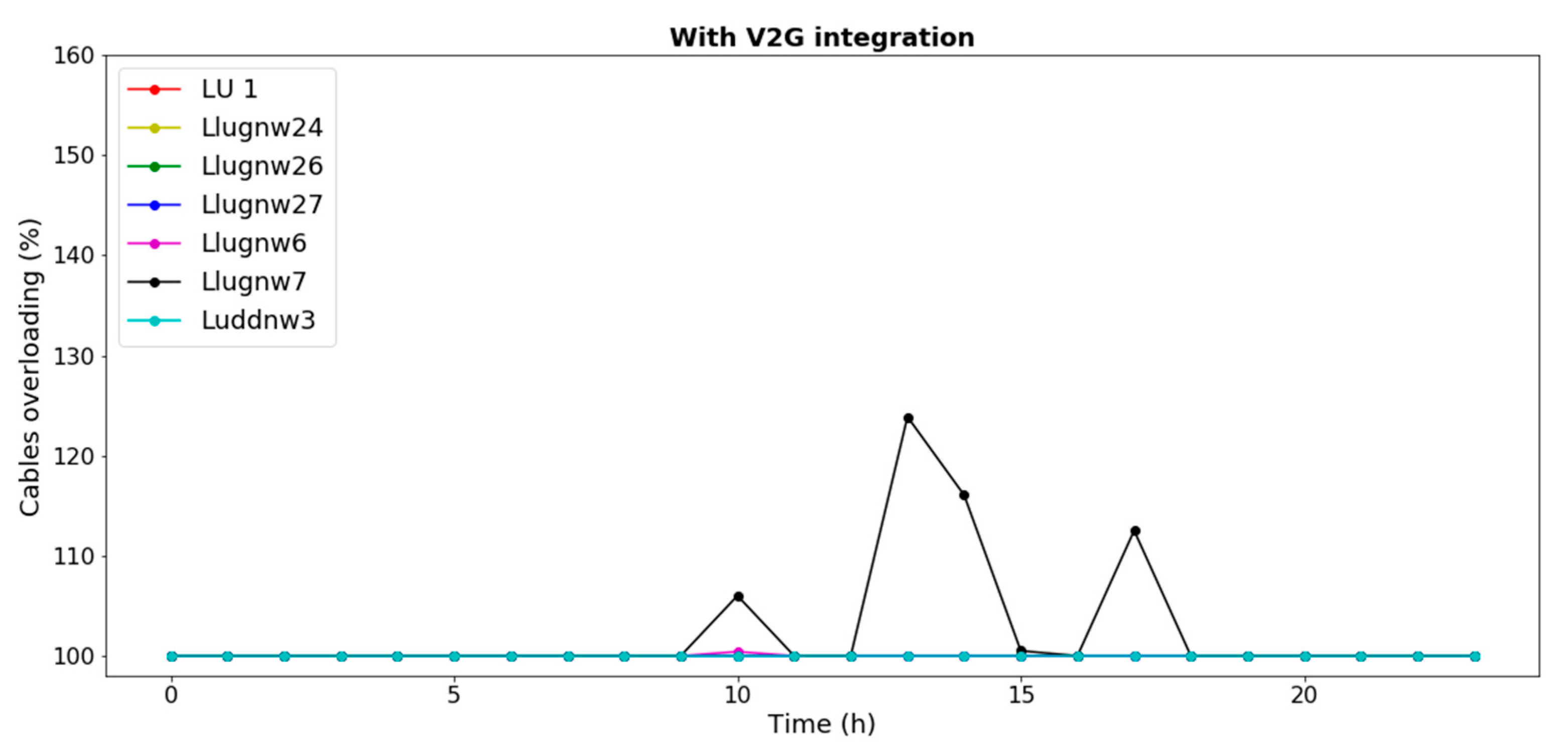
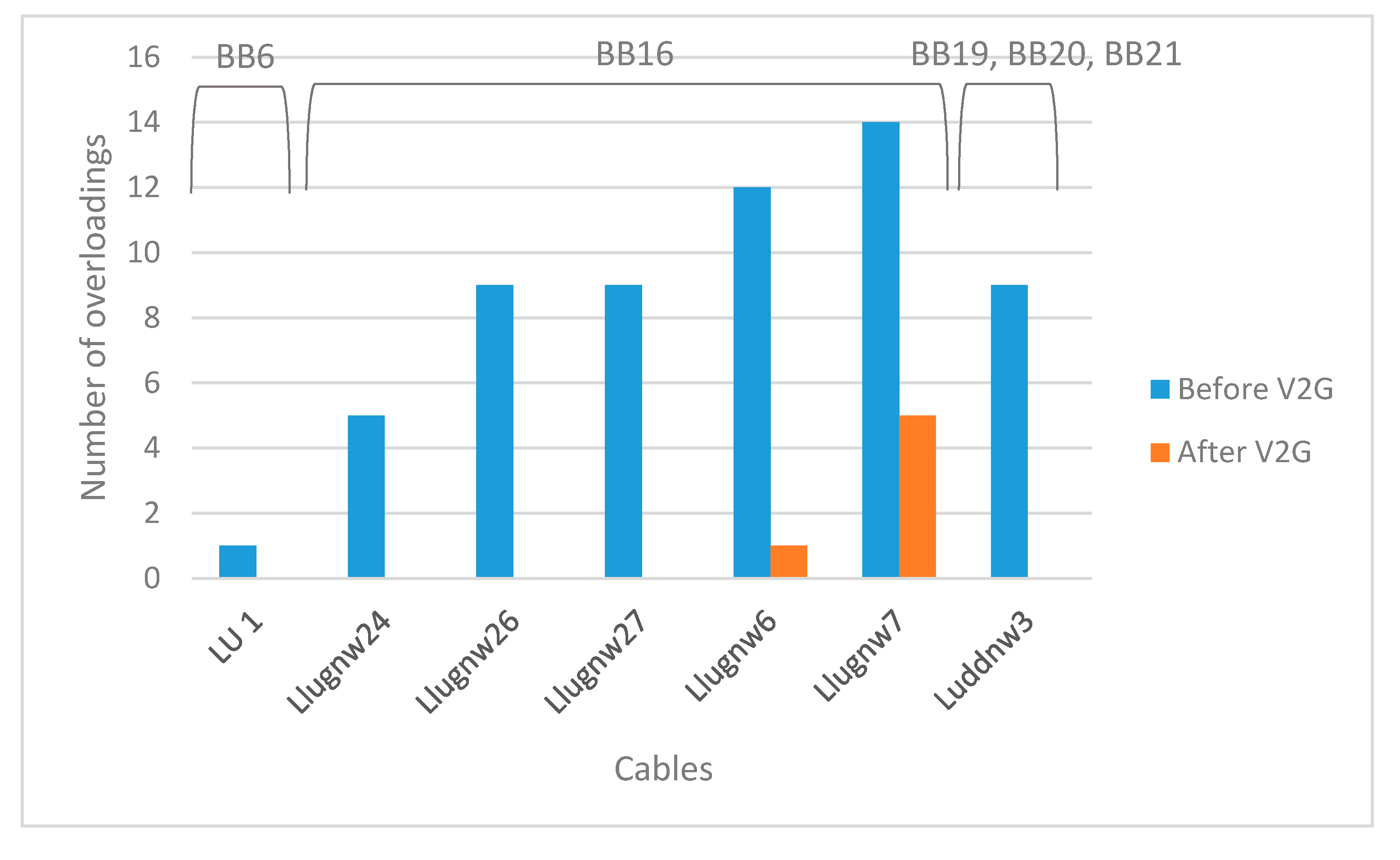
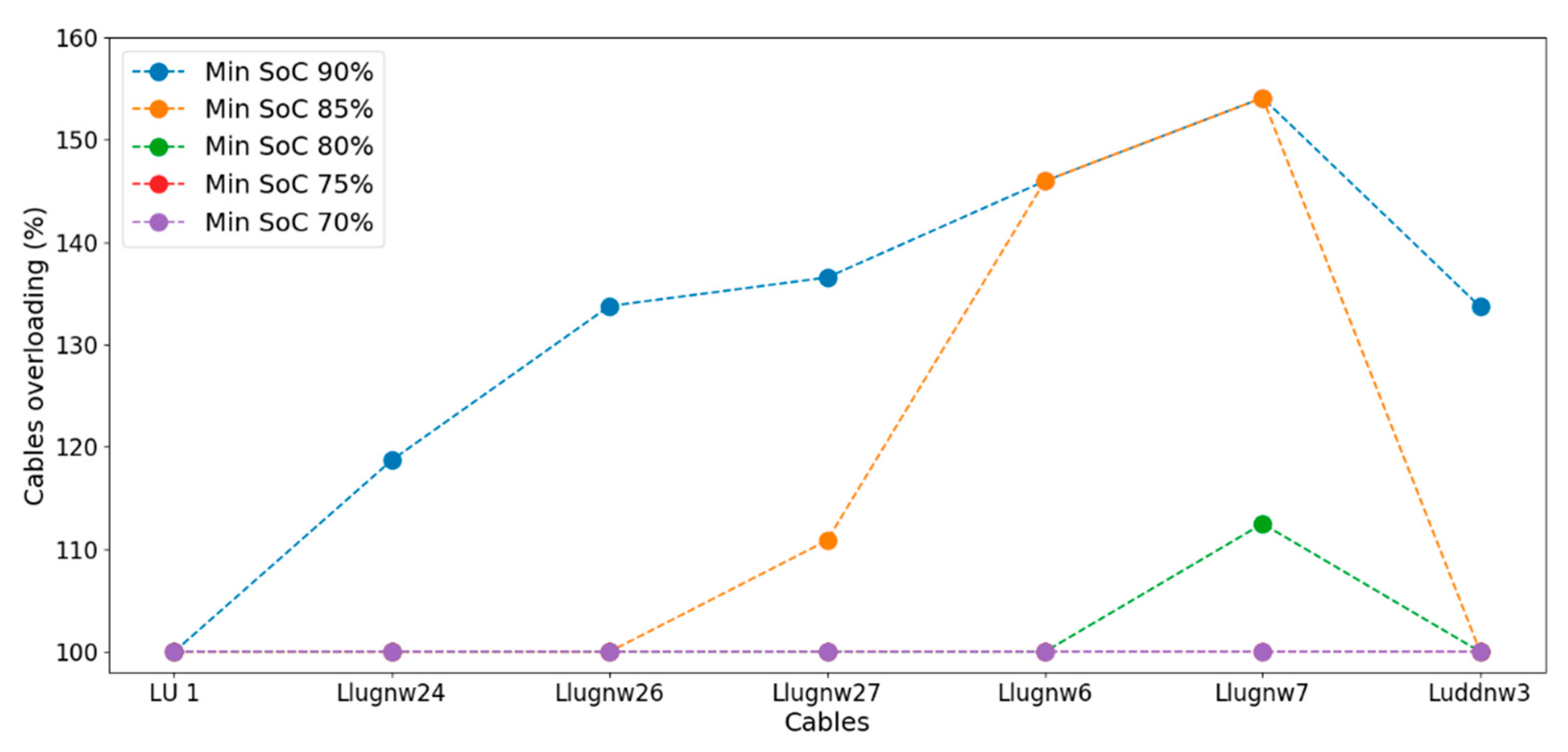
| BB1 | BB2 | BB3 | BB4 | BB5 | BB6 | BB7 | BB8 | BB9 | BB10 | BB11 |
| 4576 | 4054 | 919 | 3258 | 4889 | 8405 | 1613 | 1613 | 2831 | 1031 | 3138 |
| BB12 | BB13 | BB14 | BB15 | BB16 | BB17 | BB18 | BB19 | BB20 | BB21 | BB22 |
| 1718 | 1931 | 3340 | 5021 | 15,060 | 3466 | 10,699 | 3632 | 3560 | 3560 | 6241 |
| Inputs | Value | Unit | Reference |
|---|---|---|---|
| Number of cars per person | 0.377 | # | [35] |
| Number of people per heated m2 | 0.042 | # | [12] |
| Share of EVs in the area | 100 | % | arbitrary |
| Travel distance boundaries | 6–45 | km | [36] |
| Speed boundaries | 40–55 | km/h | [36] |
| Power exchange | 3.68 | kVA | [37] |
| SoC boundaries | 50–90 | % | arbitrary |
| Minimum SoC for discharging | 80 | % | arbitrary |
| Number of power exchange stations | 5 | # | arbitrary |
| Number of trips per day | 2 | # | arbitrary |
| BB | Number of EVs |
|---|---|
| BB6 | 130 |
| BB16 | 233 |
| BB19 | 58 |
| BB20 | 57 |
| BB21 | 57 |
© 2020 by the authors. Licensee MDPI, Basel, Switzerland. This article is an open access article distributed under the terms and conditions of the Creative Commons Attribution (CC BY) license (http://creativecommons.org/licenses/by/4.0/).
Share and Cite
Arnaudo, M.; Topel, M.; Laumert, B. Vehicle-To-Grid for Peak Shaving to Unlock the Integration of Distributed Heat Pumps in a Swedish Neighborhood. Energies 2020, 13, 1705. https://doi.org/10.3390/en13071705
Arnaudo M, Topel M, Laumert B. Vehicle-To-Grid for Peak Shaving to Unlock the Integration of Distributed Heat Pumps in a Swedish Neighborhood. Energies. 2020; 13(7):1705. https://doi.org/10.3390/en13071705
Chicago/Turabian StyleArnaudo, Monica, Monika Topel, and Björn Laumert. 2020. "Vehicle-To-Grid for Peak Shaving to Unlock the Integration of Distributed Heat Pumps in a Swedish Neighborhood" Energies 13, no. 7: 1705. https://doi.org/10.3390/en13071705
APA StyleArnaudo, M., Topel, M., & Laumert, B. (2020). Vehicle-To-Grid for Peak Shaving to Unlock the Integration of Distributed Heat Pumps in a Swedish Neighborhood. Energies, 13(7), 1705. https://doi.org/10.3390/en13071705






